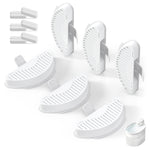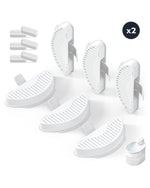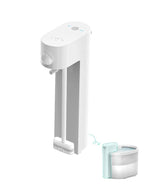When it comes to creating a healthy environment for your pets, air quality plays a crucial role. Pet air purifiers are designed to tackle the unique challenges posed by pet dander, hair, and odors. But with so many options available, how do you choose the right one? This comprehensive pet air purifier comparison will guide you through the essential factors to consider, ensuring you make an informed decision for your furry friends and your home.
Why Pet Air Purifiers Are Essential
Pets bring joy and companionship into our lives, but they also introduce allergens and pollutants into the air. Pet dander, hair, and odors can accumulate, leading to poor indoor air quality. This can affect not only your pets but also your family members, especially those with allergies or respiratory issues. A pet air purifier is specifically designed to address these challenges, capturing airborne particles and neutralizing odors to create a cleaner, healthier environment.
Key Features to Look for in a Pet Air Purifier
When comparing pet air purifiers, it's important to consider several key features that can impact their effectiveness. Here are some of the most critical factors to evaluate:
HEPA Filters
High-Efficiency Particulate Air (HEPA) filters are a must-have for any pet air purifier. These filters are capable of capturing 99.97% of airborne particles as small as 0.3 microns, including pet dander, pollen, and dust mites. Ensure the purifier you choose has a true HEPA filter for optimal performance.
Activated Carbon Filters
Activated carbon filters are essential for neutralizing odors. These filters absorb and trap volatile organic compounds (VOCs) and other odor-causing molecules, leaving your home smelling fresh. Look for a purifier with a substantial activated carbon layer to effectively tackle pet odors.
Air Change Rate
The air change rate refers to how many times the purifier can filter the entire volume of air in a room per hour. A higher air change rate means the purifier can clean the air more frequently, which is especially important in homes with multiple pets or larger spaces.
Noise Level
Pets can be sensitive to noise, so it's important to choose a purifier that operates quietly. Look for models with low decibel ratings, especially if you plan to use the purifier in a bedroom or other quiet space.
Coverage Area
The coverage area indicates the maximum size of the room the purifier can effectively clean. Make sure to choose a purifier that matches the size of the room where it will be used. A purifier with a larger coverage area can handle more space, but it may also be more expensive.
Types of Pet Air Purifiers
There are several types of pet air purifiers available, each with its own set of features and benefits. Understanding the differences can help you choose the right one for your needs.
Standalone Purifiers
Standalone purifiers are the most common type and are designed to be placed in a specific room. They are typically portable and come in various sizes to accommodate different room dimensions. These purifiers are ideal for targeted air cleaning in areas where pets spend most of their time.
Whole-House Purifiers
Whole-house purifiers are integrated into your home's HVAC system, providing air cleaning for the entire house. These systems are more expensive but offer comprehensive air purification for larger homes with multiple pets.
Portable Purifiers
Portable purifiers are compact and easy to move from room to room. They are ideal for smaller spaces or for use in multiple areas of the home. These purifiers are often more affordable and can be a good option for pet owners on a budget.
Maintenance and Upkeep
Regular maintenance is essential to keep your pet air purifier functioning effectively. Here are some tips to ensure your purifier remains in top condition:
Filter Replacement
Most purifiers require periodic filter replacements to maintain their performance. Check the manufacturer's recommendations for how often to replace the HEPA and activated carbon filters. Keeping a schedule for filter changes can help ensure your purifier continues to work efficiently.
Cleaning
Some purifiers have washable pre-filters or other components that need regular cleaning. Follow the manufacturer's instructions for cleaning to prevent the buildup of dust and debris, which can reduce the purifier's effectiveness.
Monitoring Air Quality
Some advanced purifiers come with air quality sensors that monitor the level of pollutants in the air. These sensors can provide real-time feedback and adjust the purifier's settings automatically. If your purifier has this feature, make sure to use it to maintain optimal air quality.
Cost Considerations
The cost of a pet air purifier can vary widely depending on the features, type, and brand. Here are some factors to consider when evaluating the cost:
Initial Purchase Price
The upfront cost of the purifier is an important consideration, but it's not the only factor. Higher-priced models often come with advanced features and better performance, which can be worth the investment in the long run.
Operating Costs
Consider the ongoing costs of operating the purifier, including electricity consumption and filter replacements. Some purifiers are more energy-efficient than others, which can save you money over time.
Long-Term Value
Think about the long-term value of the purifier. A more expensive model with better performance and durability may be a better investment than a cheaper model that needs frequent repairs or replacements.
Tips for Choosing the Right Pet Air Purifier
With so many options available, it can be challenging to choose the right pet air purifier. Here are some tips to help you make the best decision:
Assess Your Needs
Consider the specific needs of your household, including the number of pets, the size of your home, and any allergies or respiratory issues. This will help you narrow down your options and choose a purifier that meets your requirements.
Read Reviews
Customer reviews can provide valuable insights into the performance and reliability of different purifiers. Look for reviews from other pet owners to see how well the purifier handles pet-related air quality issues.
Compare Features
Make a list of the features that are most important to you and compare different models based on these criteria. This will help you find a purifier that offers the best combination of features for your needs.
Check Warranty and Support
Look for purifiers that come with a warranty and reliable customer support. This can provide peace of mind and ensure you have assistance if you encounter any issues with the purifier.
Choosing the right pet air purifier can make a significant difference in the air quality of your home and the health of your pets. By considering the key features, types, and maintenance requirements, you can find a purifier that meets your needs and provides a cleaner, healthier environment for your furry friends. Don't wait—start your pet air purifier comparison today and take the first step toward better air quality for your home and pets.












